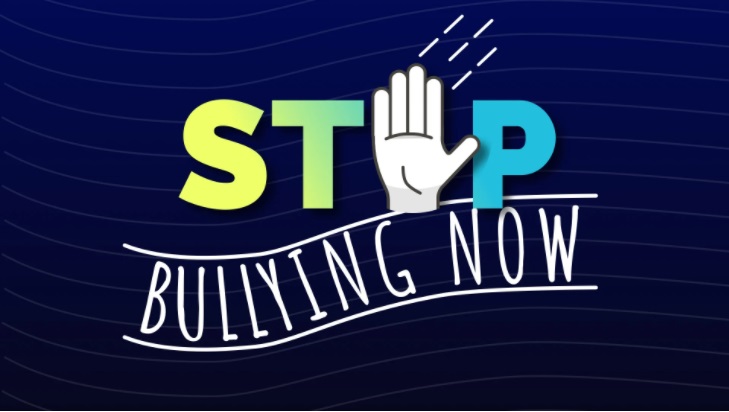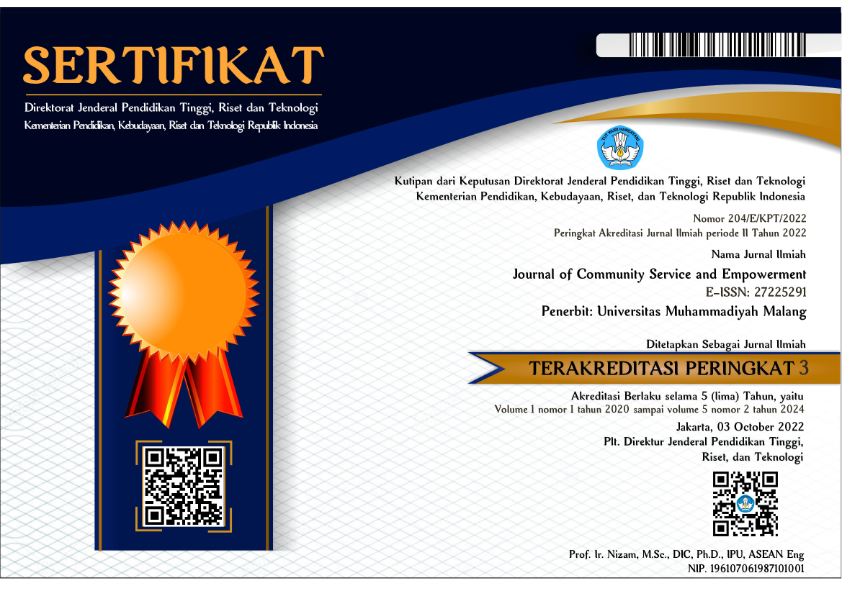Psychoeducation of preventive action against bullying behavior in MIN 1 Blitar
DOI:
https://doi.org/10.22219/jcse.v1i3.12307Keywords:
Bullying, Preventive, PsychoeducationAbstract
Bullying in schools is one or a factor that becomes a problem / obstacle in achieving the Sustainable Development Goals (SDGs), so that campaigns and enlightenment to the public about the various impacts and efforts to overcome bullying must be encouraged. In this regard, this article aims to describe the preventive action psychoeducation service activities against bullying behavior at MIN 1 Blitar. Community service participants are Teachers and Parents of Students of MIN 1 Blitar. The target of this community service is that teachers and parents at MIN 1 Blitar are able to understand the condition of students or their children so that they are not prone to becoming victims of bullying or becoming perpetrators of bullying, creating a Peaceful school. The method used is to provide a scale of Bullying, psychoeducation and focus group discussion (FGD) to teachers and parents of students of MIN 1 Blitar. Based on the post-test results of the fifth-grade students of MIN 1 Blitar, it is known that 6.5% were identified as bullying perpetrators while 15% were identified as victims of bullying. This service activity is carried out in several forms, namely psychoeducation, FGD and self-help groups, which are preventive measures of psychoeducation against bullying behavior.
Downloads
References
Al-Saadoon, M., Al-Farsi, Y. M., Rizvi, S., Al-Sharbati, M., Al-Jabri, A., Almamari, S., Al-Baluki, W., & Al-Adawi, S. (2014). The magnitude and impact of bullying among school pupils in Muscat, Oman: A cross-sectional study. Scientific World Journal, 2014. https://doi.org/10.1155/2014/169737
Arseneault, L, Bowes, L., & Shakoor, S. (2010). Bullying victimization in youths and mental health problems: ‘Much ado about nothing’? Psychological Medicine, 40(5), 717–729. https://doi.org/10.1017/S0033291709991383
Arseneault, Louise. (2018). Annual research review: The persistent and pervasive impact of being bullied in childhood and adolescence: implications for policy and practice. Journal of Child Psychology and Psychiatry and Allied Disciplines, 59(4), 405–421. https://doi.org/10.1111/jcpp.12841
BAPPENAS, & UNICEF. (2017). Laporan Baseline SDG tentang Anak-Anak di Indonesia. Kementerian Perencanaan Pembangunan Nasional (Bappenas) dan United Nations Children’s Fund.
Bjereld, Y., Daneback, K., & Mishna, F. (2019). Adults’ responses to bullying: the victimized youth’s perspectives. Research Papers in Education, 00(00), 1–18. https://doi.org/10.1080/02671522.2019.1646793
Challenger Limited. (2019). 2019 Sustainability Report. Challenger Limited, XV(2), 80–85.
Darmawan, D. (2017). Fenomena bullying (perisakan) di lingkungan sekolah. Jurnal Kependidikan, 1(2), 253–262.
Fanti, K. a, & Georgiou, S. N. (2013). Bullying, victimization, school performance, and mother-child relationship quality: Direct and transactional associations. Journal OfCriminology, 2013(289689), 1–11. https://doi.org/10.1155/2013/289689
Forssell, R. (2016). Exploring cyberbullying and face-to-face bullying in working life - Prevalence, targets and expressions. Computers in Human Behavior, 58, 454–460. https://doi.org/10.1016/j.chb.2016.01.003
Garandeau, C. F., Lee, I. A., & Salmivalli, C. (2016). Decreases in the proportion of bullying victims in the classroom: Effects on the adjustment of remaining victims. International Journal of Behavioral Development, 42(1), 64–72. https://doi.org/10.1177/0165025416667492
Guerra, N. G., Williams, K. R., & Sadek, S. (2011). Understanding bullying and victimization during childhood and adolescence: A mixed methods study. Child Development, 82(1), 295–310. https://doi.org/10.1111/j.1467-8624.2010.01556.x
Hansen, H. H., Hasselgård, C. E., Undheim, A. M., & Indredavik, M. S. (2014). Bullying behaviour among Norwegian adolescents: Psychiatric diagnoses and school well-being in a clinical sample. Nordic Journal of Psychiatry, 68(5), 355–361. https://doi.org/10.3109/08039488.2013.845689
Hidayati, N. (2012). Bullying pada anak: Analisis dan alternatif solusi. Jurnal Insan, 14(1), 41–48. http://www.journal.unair.ac.id/filerPDF/artikel 5-14-1.pdf
Hong, J. S., Espelage, D. L., & Rose, C. A. (2019). Bullying, peer victimization, and child and adolescent health: An introduction to the special issue. Journal of Child and Family Studies, 28(9), 2329–2334. https://doi.org/10.1007/s10826-019-01502-9
Houbre, B., Tarquinio, C., Thuillier, I., & Hergott, E. (2006). Bullying among students and its consequences on health. European Journal of Psychology of Education, 21(2), 183–208. https://doi.org/10.1007/BF03173576
Istiqomah, I., & Hidayati, D. S. (2019). Perbedaan psychological well being pada pelaku dan korban bullying.
Jan, A., & Husain, S. (2015). Bullying in elementary schools: Its causes and effects on students. Journal of Education and Practice, 6(19), 43–57.
Keating, S., Mazzone, A., Milosevic, T., & Norman, J. O. (2020). School Bullying with specific reference to cyberbullying and internet security during Covid-19 (Issue 14). The National Anti-Bullying Research and Resource Centre (ABC).
Kvarme, L. G., Aabø, L. S., & Sæteren, B. (2016). From victim to taking control: Support group for bullied schoolchildren. The Journal of School Nursing, 32(2), 112–119. https://doi.org/10.1177/1059840515590608
Levianti, L. (2008). Konformitas dan Bullying pada Siswa. Jurnal Psikologi, 6(1), 1.
Mcdougall, P., & Vaillancourt, T. (2015). Long-term adult outcomes of peer victimization in childhood and adolescence. American Psychologist, 70(4), 300–310.
Menesini, E., & Salmivalli, C. (2017). Bullying in schools: the state of knowledge and effective interventions. Psychology, Health and Medicine, 22, 240–253. https://doi.org/10.1080/13548506.2017.1279740
Monks, C. P., Mahdavi, J., & Rix, K. (2016). The emergence of cyberbullying in childhood: Parent and teacher perspectives. Psicologia Educativa, 22(1), 39–48. https://doi.org/10.1016/j.pse.2016.02.002
Moore, S. E., Norman, R. E., Suetani, S., Thomas, H. J., Sly, P. D., & Scott, J. G. (2017). Consequences of bullying victimization in childhood and adolescence: A systematic review and meta-analysis. World Journal of Psychiatry, 7(1), 60. https://doi.org/10.5498/wjp.v7.i1.60
Nasir, A. (2018). Konseling behavioral: Solusi alternatif mengatasi bullying anak di sekolah. KONSELING EDUKASI “Journal of Guidance and Counseling,” 2(1), 67–82. https://doi.org/10.21043/konseling.v2i2.4466
Nastiti, F. E., Prastyanti, R. A., & Srirahayu, A. (2019). Advokasi UU ITE: Peningkatan kewaspadaan guru terhadap serangan cyberbullying antar peserta didik di gugus II Harjuno (Pengabdian masyarakat pada gugus II Harjuno Surakarta). Jurnal INFORMA Politeknik Indonusa Surakarta, 5(3), 6–10. http://informa.poltekindonusa.ac.id/index.php/informa/article/view/134
Nilan, P., Burgess, H., Hobbs, M., Threadgold, S., & Alexander, W. (2015). Youth, social media, and cyberbullying among Australian youth: “Sick Friends.” Social Media and Society, 1(2), 1–12. https://doi.org/10.1177/2056305115604848
Ningrum, A. W., Christiana, E., Nursalim, M., & Lukitaningsih, R. (2016). Studi tentang perilaku bullying di sekolah menengah pertama Se-Kecamatan Prajurit Kulon Kota Mojokerto serta penanganan oleh guru BK. Jurnal BK UNESA, 6(1), 1–8.
Octavia, D., Puspita, M., & Yan, L. S. (2020). Fenomena perilaku bullying pada anak di tingkat Sekolah Dasar. Riset Informasi Kesehatan, 9(1), 43. https://doi.org/10.30644/rik.v9i1.273
Oliveira, F. R., de Menezes, T. A., Irffi, G., & Oliveira, G. R. (2018). Bullying effect on student’s performance. EconomiA, 19(1), 57–73. https://doi.org/10.1016/j.econ.2017.10.001
Pan, Y., Liu, H., Lau, P., & Luo, F. (2017). A latent transition analysis of bullying and victimization in Chinese primary school students. PLoS ONE, 12(8), 1–15. https://doi.org/10.1371/journal.pone.0182802
Putri, A. D. S., & Budiman, M. A. (2019). Bullying analysis in SDN Pandean Lamper 02 Kota Semarang. 4th National Seminar on Educational Innovation (SNIP 2019), 2(1), 226 – 231.
Rigby, K. (2003). Consequences of Bullying in Schools. Canadian Journal of Psychiatry, 48(9), 583–590. https://doi.org/10.1177/070674370304800904
Rigby, K. (2020). How teachers deal with cases of bullying at school: What victims say. International Journal of Environmental Research and Public Health, 17(7). https://doi.org/10.3390/ijerph17072338
Rivara, F., & Le Menestrel, S. (2016). Preventing bullying through science, policy, and practice. In Preventing Bullying Through Science, Policy, and Practice. https://doi.org/10.17226/23482
Sarwono, S. W., & Meinarno, E. A. (2009). Psikologi sosial. Salemba.
Scholte, R. H. J., Engels, R. C. M. E., Overbeek, G., De Kemp, R. A. T., & Haselager, G. J. T. (2007). Stability in bullying and victimization and its association with social adjustment in childhood and adolescence. Journal of Abnormal Child Psychology, 35(2), 217–228. https://doi.org/10.1007/s10802-006-9074-3
Shetgiri, R. (2013). Bullying and victimization among children. Advances in Pediatrics, 60(1), 33–51. https://doi.org/10.1016/j.yapd.2013.04.004
Simbolon, M. (2013). Perilaku bullying pada mahasiswa berasrama. Jurnal Psikologi, 39(2), 233–243. https://doi.org/10.22146/jpsi.6989
Smith, P. K., Bauman, S., & Wong, D. (2019). Interventions to Reduce Bullying and Cyberbullying. In Interventions to Reduce Bullying and Cyberbullying. https://doi.org/10.3390/books978-3-03921-360-3
Stuart-cassel, V., Terzian, M., & Bradshaw, C. (2013). Social bullying: Correlates, consequences, and prevention. Safe Supportive Learning, In Brief(May), 1–13.
Sucipto, S. (2012). Bullying dan upaya meminimalisasikannya. Psikopedagogia, 1(1), 1–12.
Swearer, S. M., & Hymel, S. (2015). Understanding the psychology of bullying: Moving toward a social-ecological diathesis-stress model. American Psychologist, 70(4), 344–353. https://doi.org/10.1037/a0038929
Tristanti, I., Nisak, A. Z., & Azizah, N. (2020). Bullying dan efeknya bagi siswa sekolah dasar di Kabupaten Kudus. Jurnal Ilmu Keperawatan Dan Kebidanan, 11(1), 1–5.
UNESCO. (2017a). Education for sustainable development goals learning objectives. UNESCO Education Sector.
UNESCO. (2017b). School violence and bullying: Global status report. International Symposium on School Violence and Bullying: From Evidence to Action, Seoul, Republic of Korea, 17 – 19 January 2017.
Utami, T. W. (2008). Pengaruh self help group terhadap kemampuan keluarga dalam merawat klien gangguan jiwa di Kelurahan Sindang Barang Bogor. Universitas Indonesia.
Van Werf, C. Der. (2014). The effects of bullying on academic achievement. Desarrollo y Sociedad, 74(2), 275–308. https://doi.org/10.13043/DYS.74.6
Yusuf, H., & Fahrudin, A. (2012). Perilaku bullying: Asesmen multidimensi dan intervensi sosial. Jurnal Psikologi, 11(2), 1–10. https://doi.org/10.14710/jpu.11.2.10

Downloads
Published
How to Cite
Issue
Section
License
Copyright (c) 2020 Istiqomah & Hidayati

This work is licensed under a Creative Commons Attribution-ShareAlike 4.0 International License.












